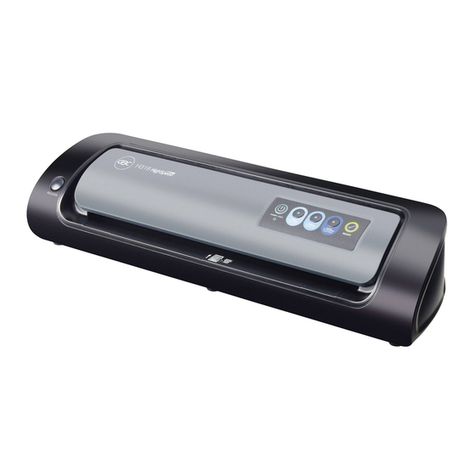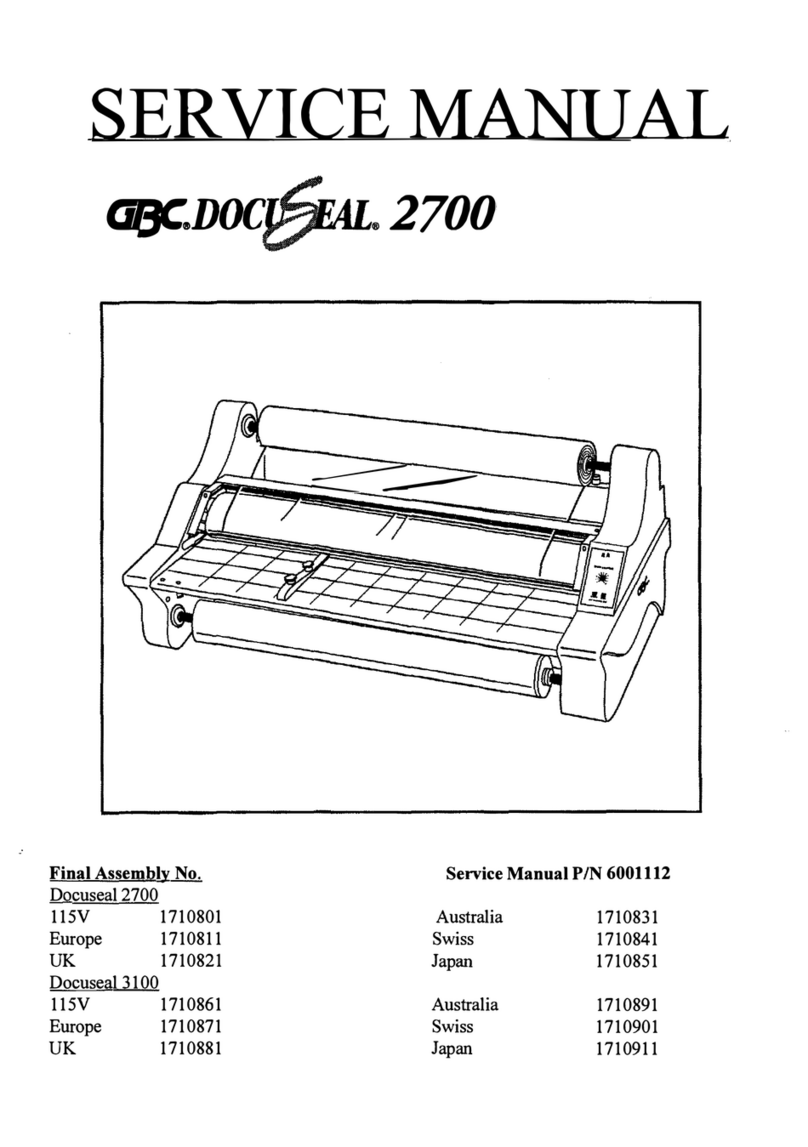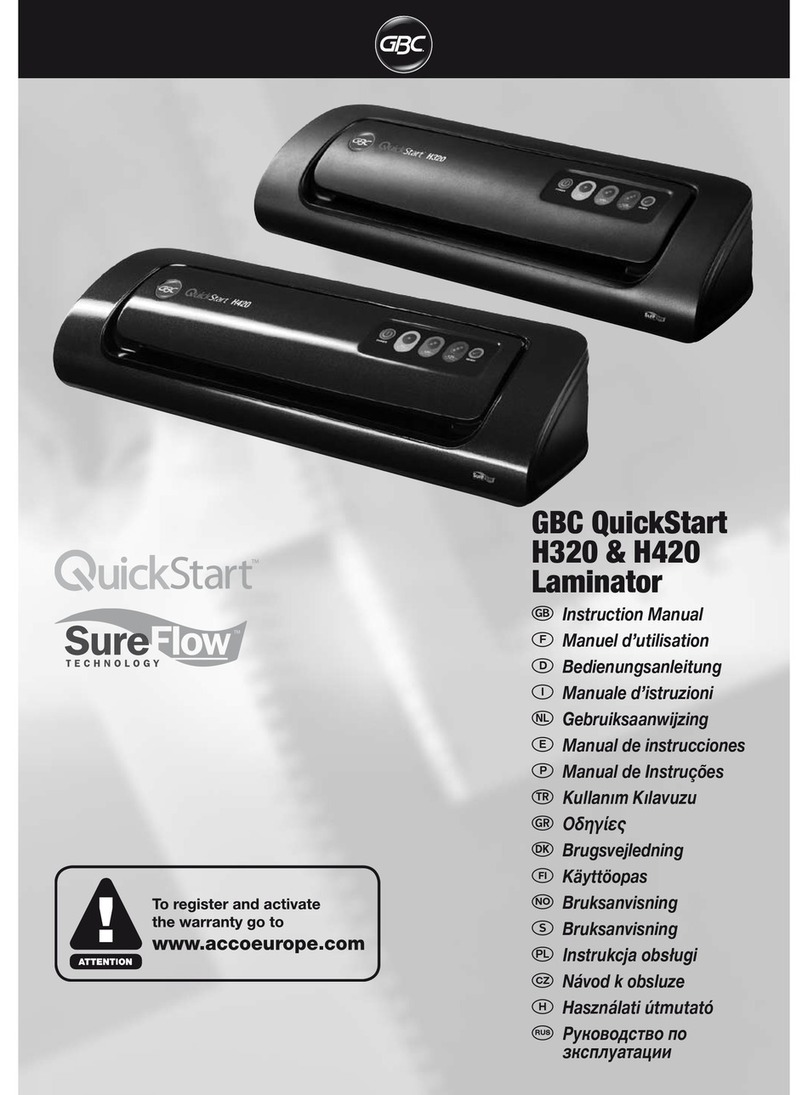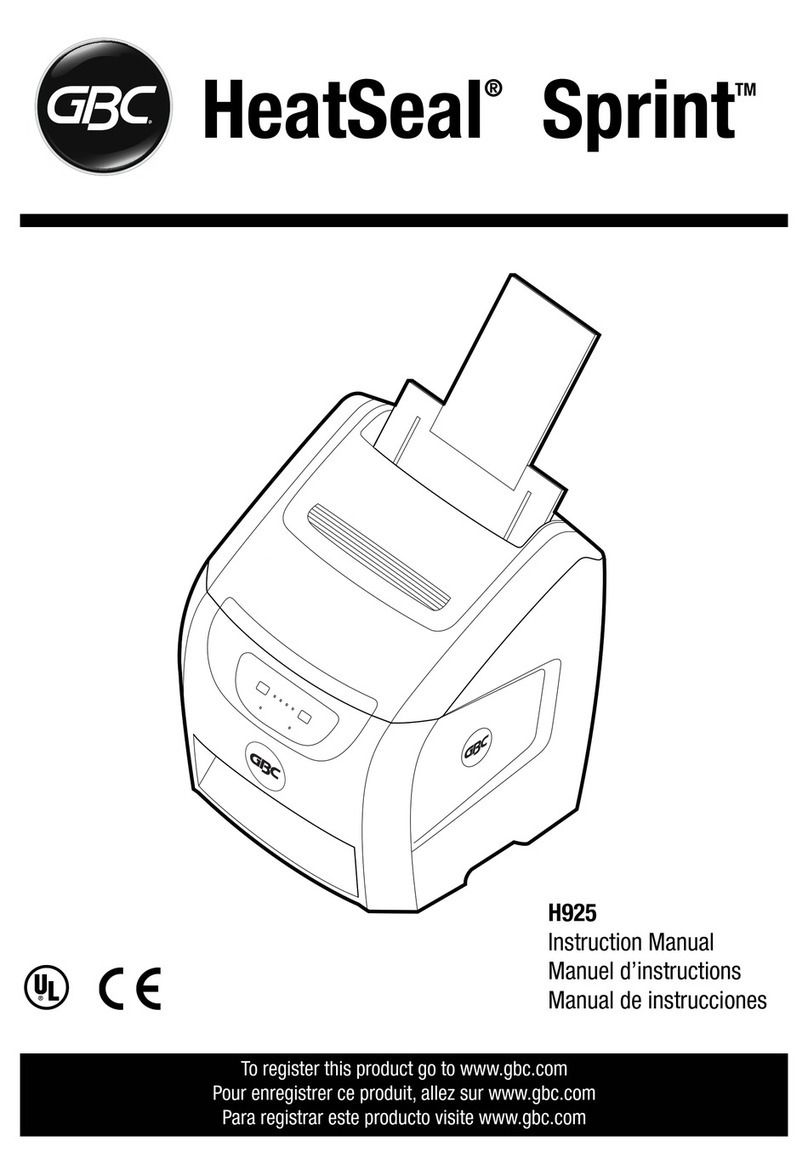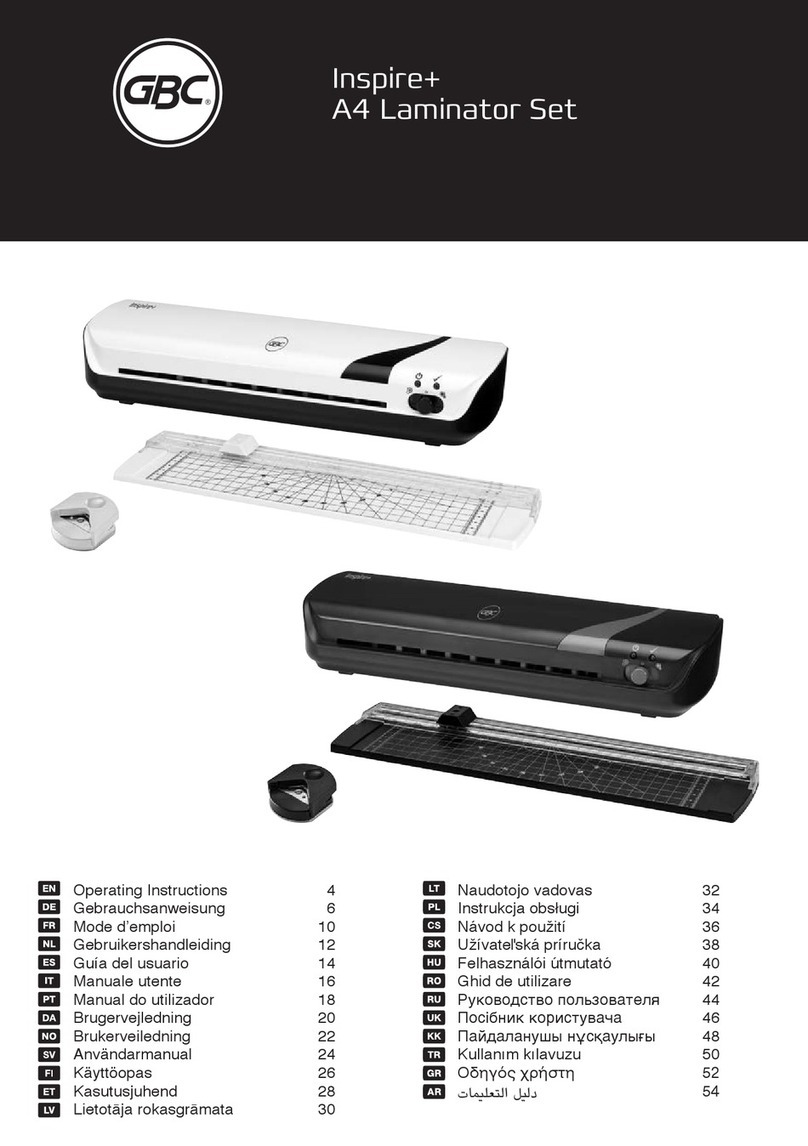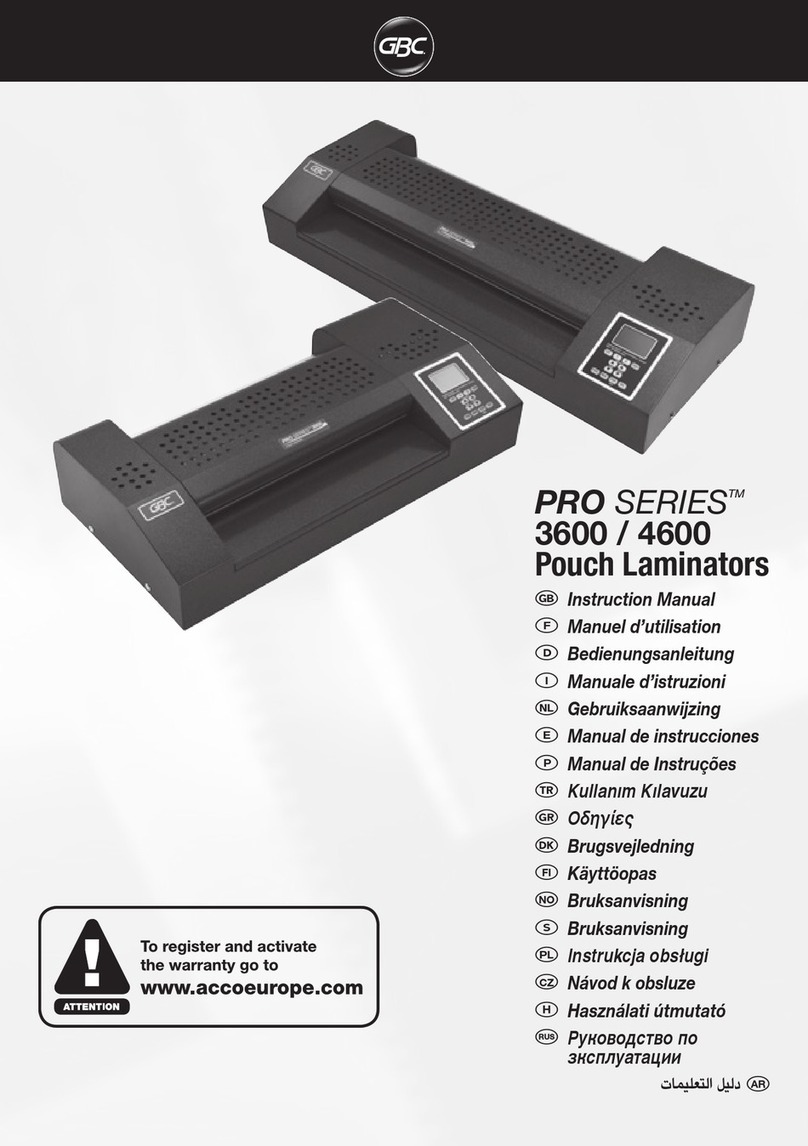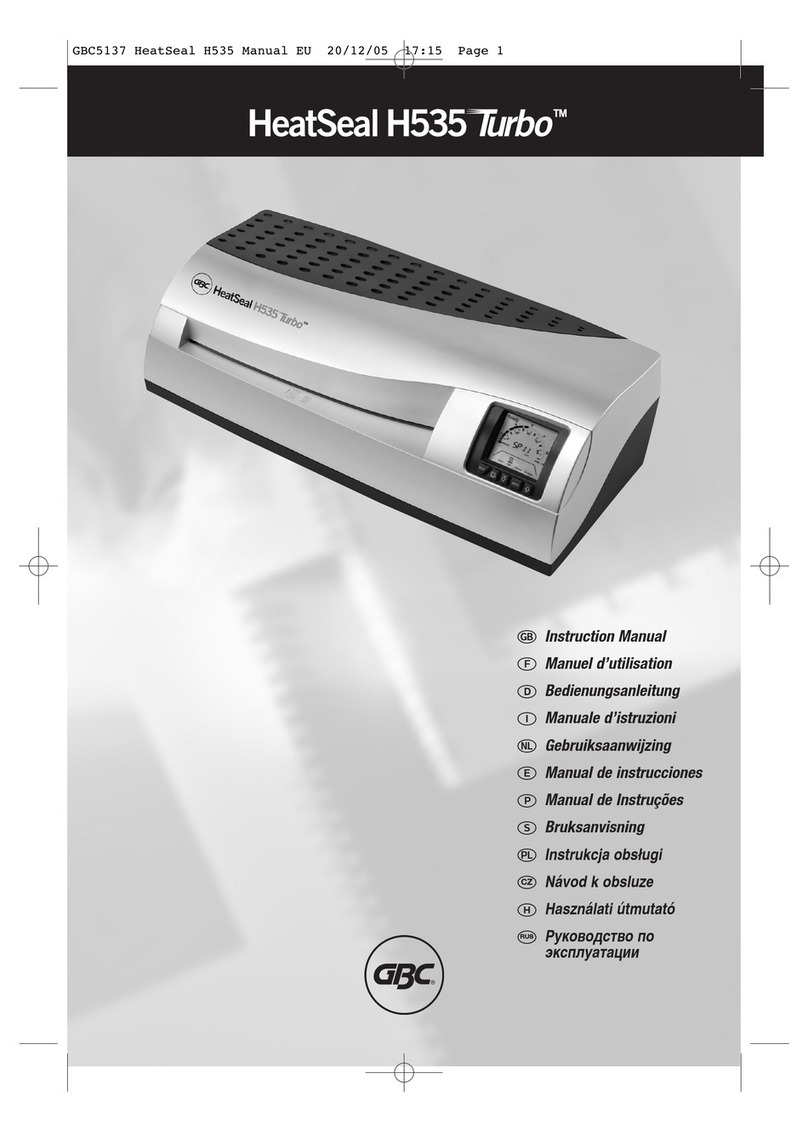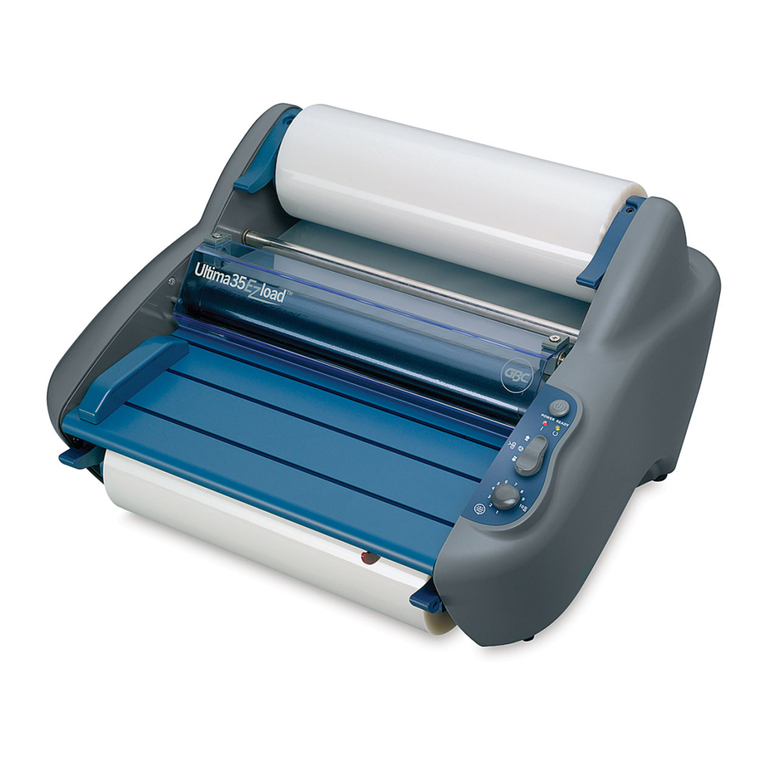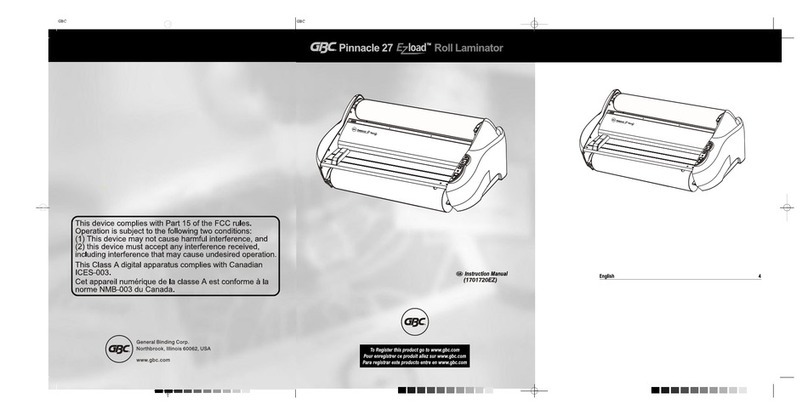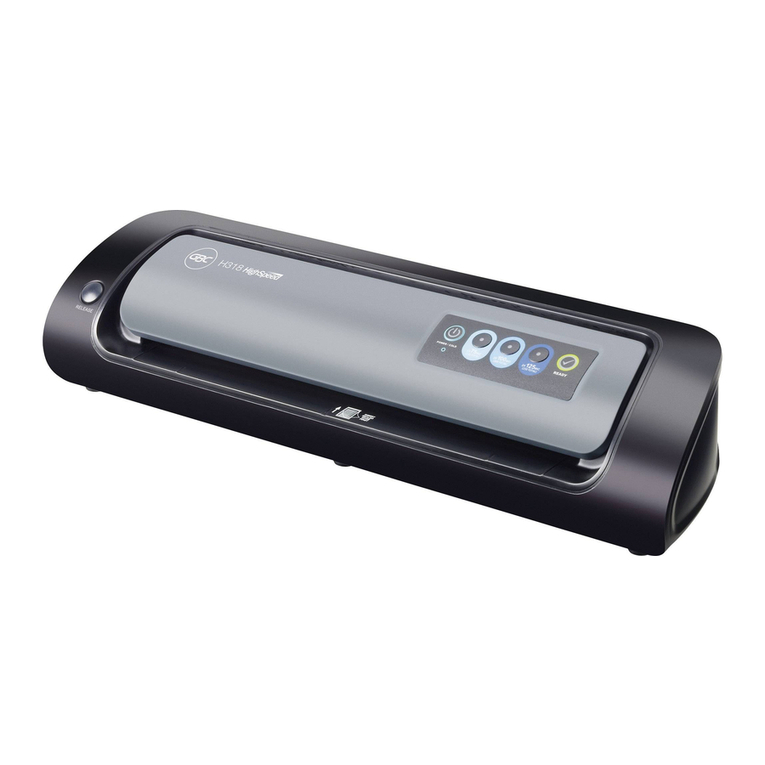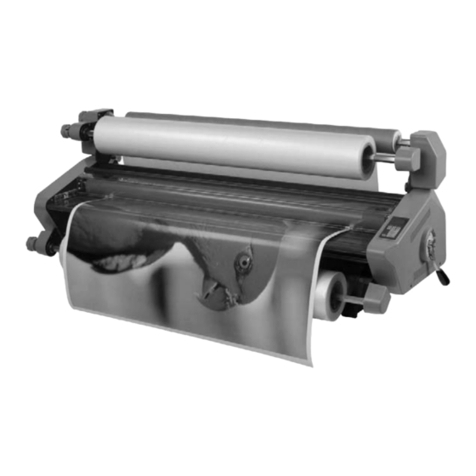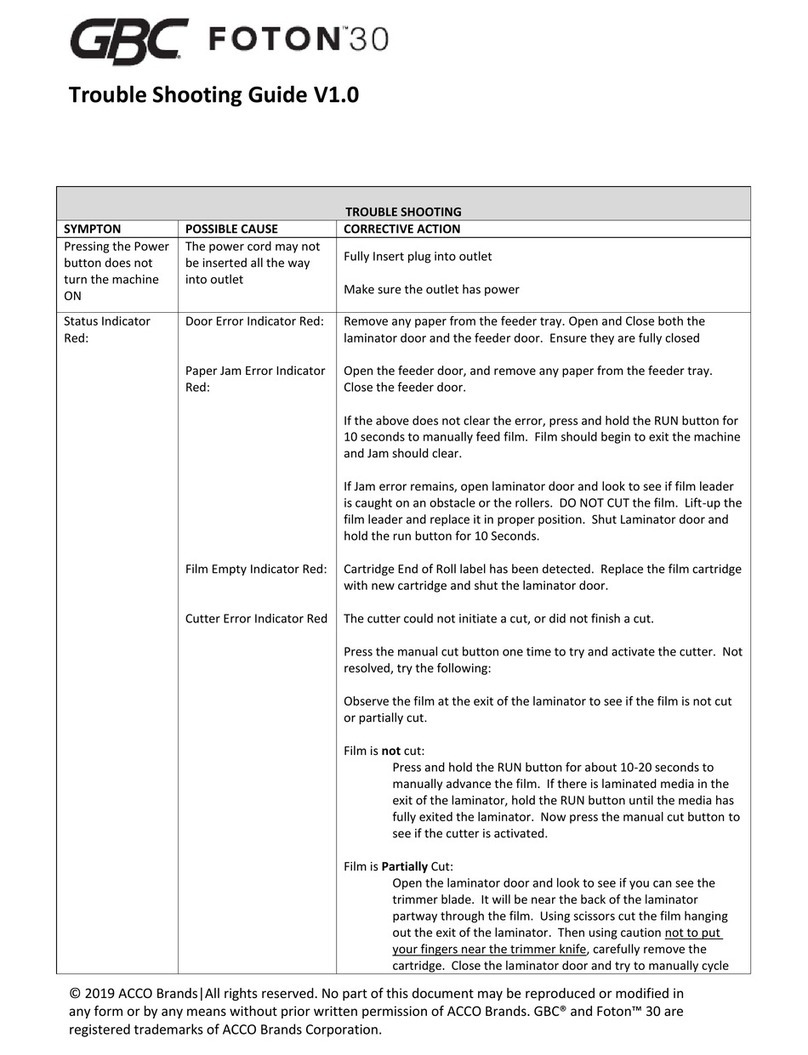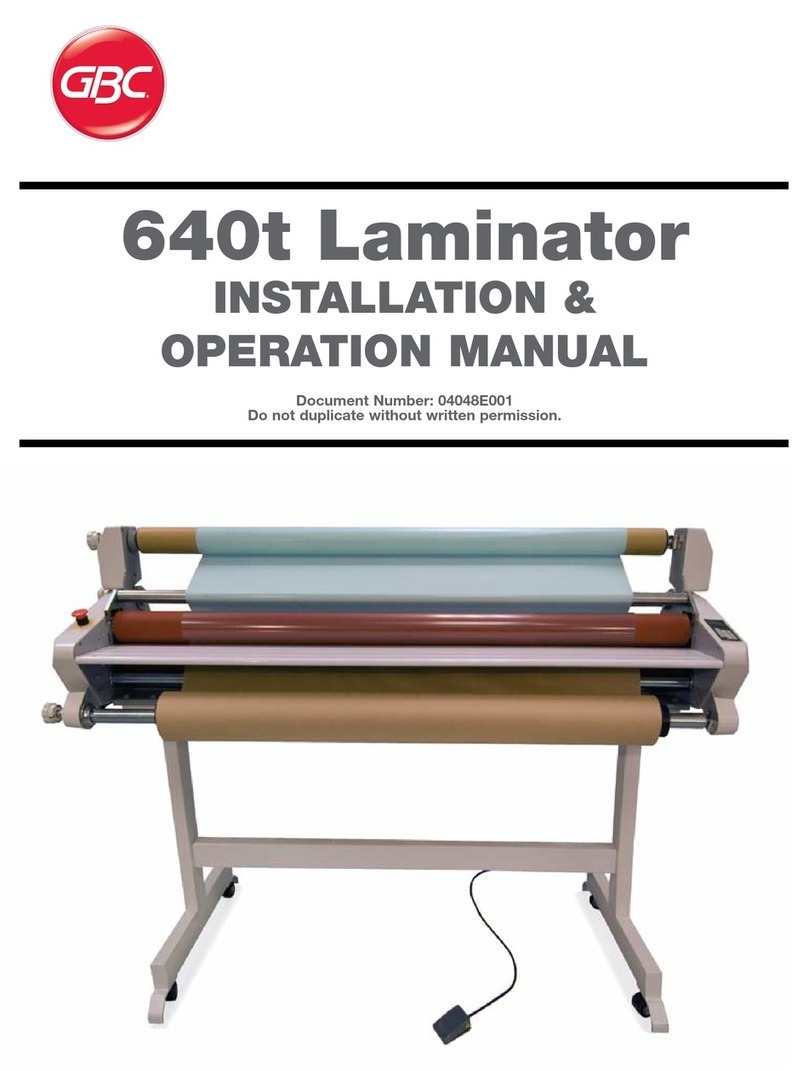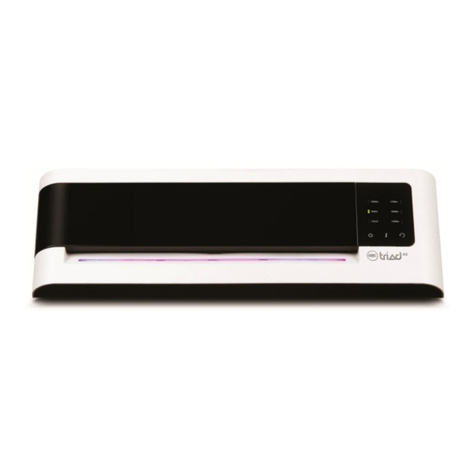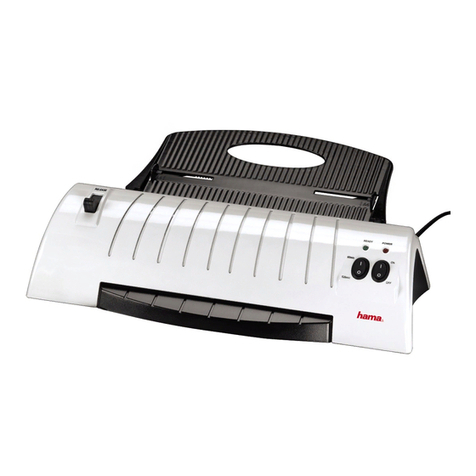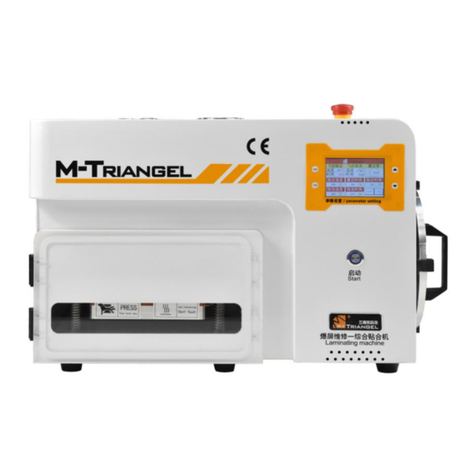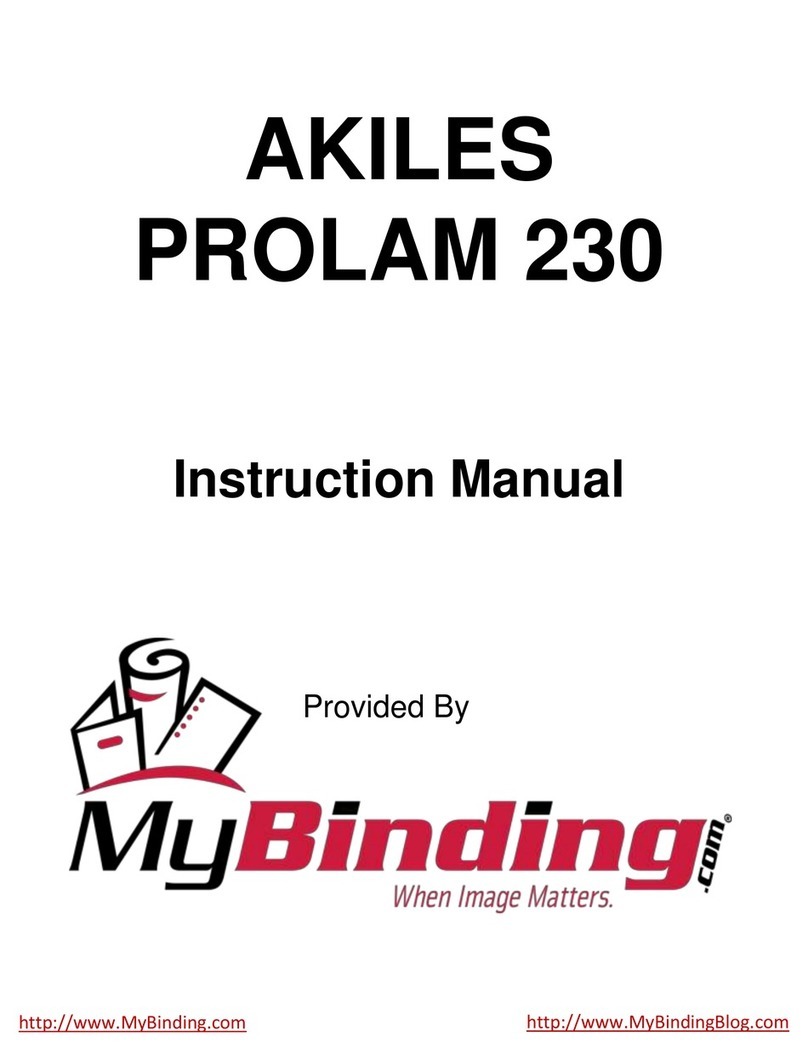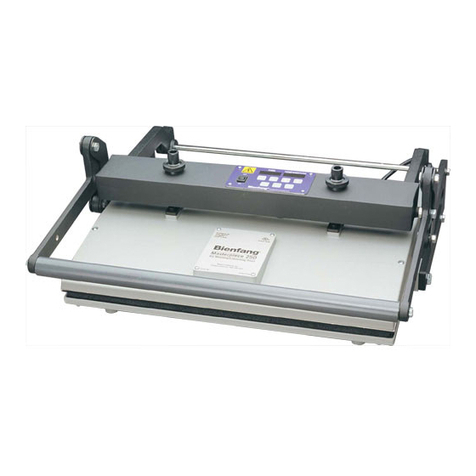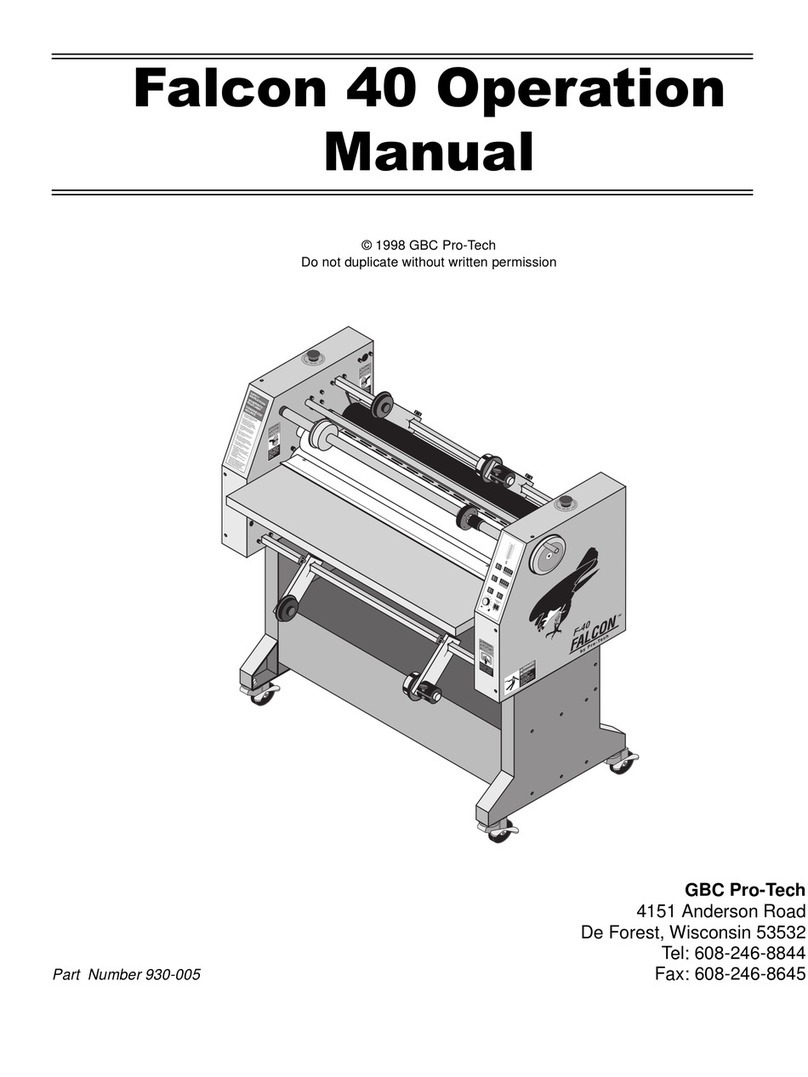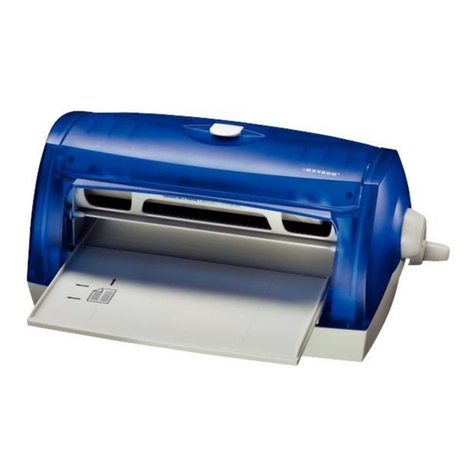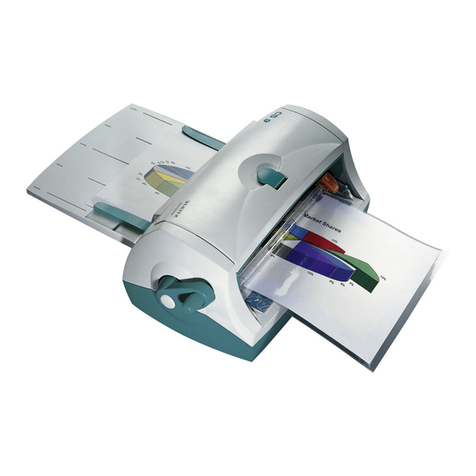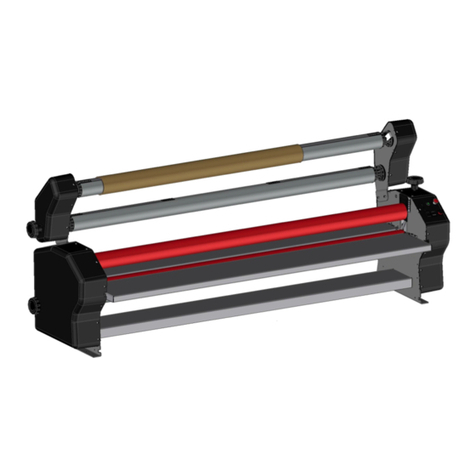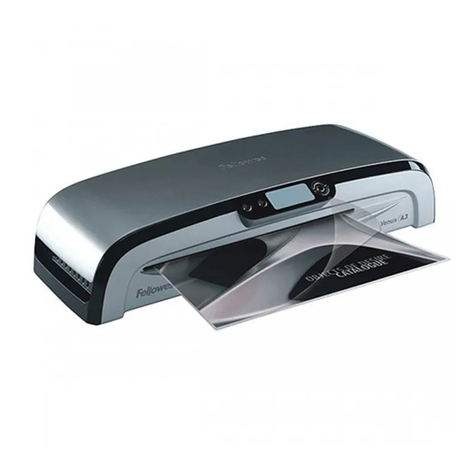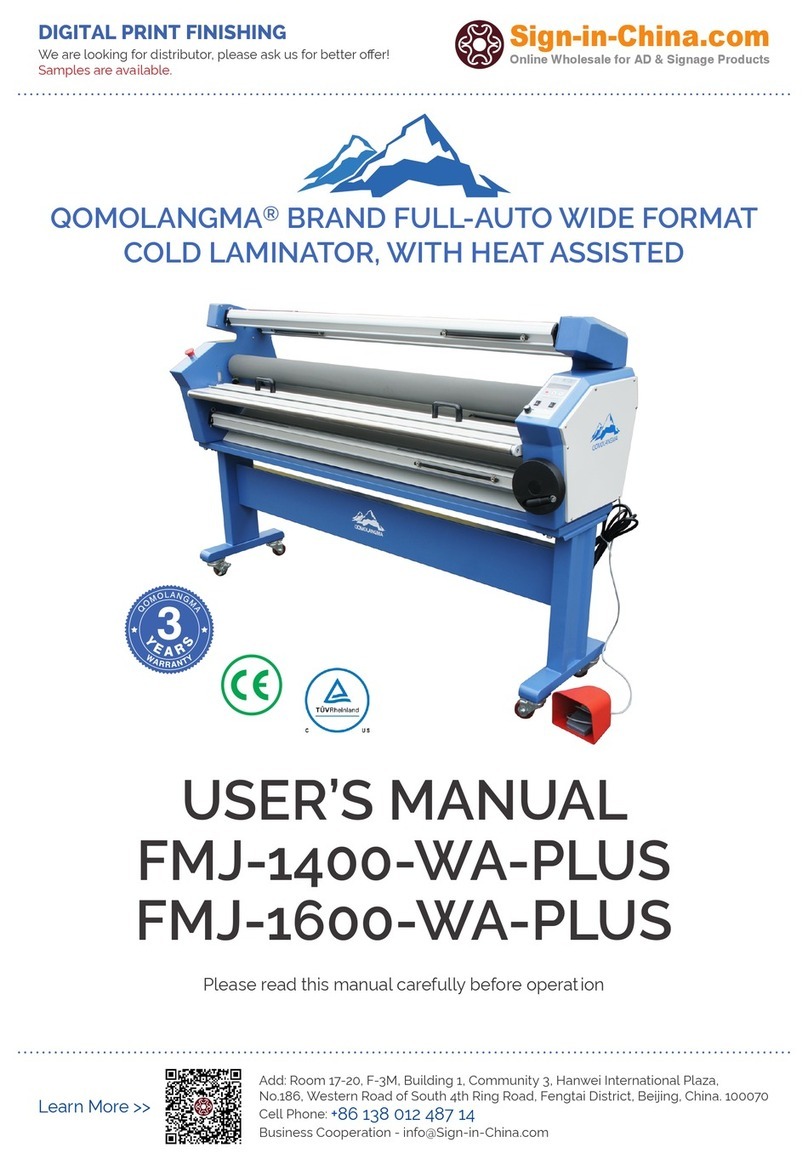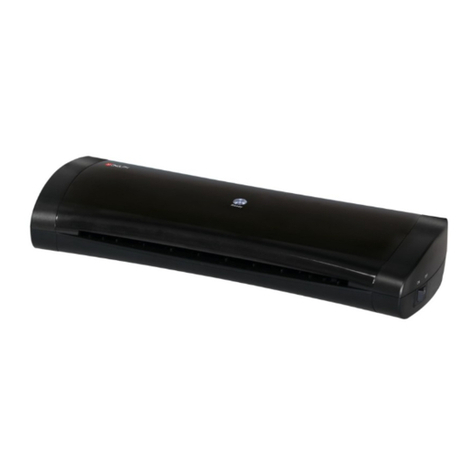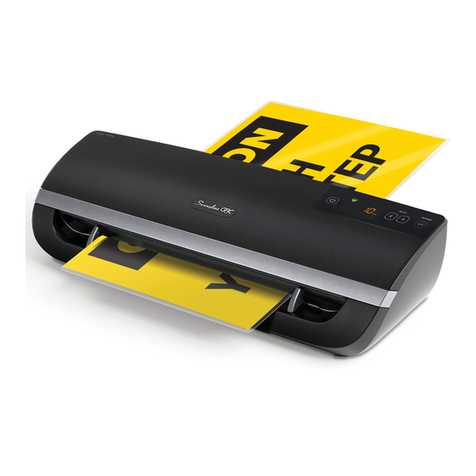Die einzige vom Nutzer durchzuführende Wartung besteht in der regelmäßigen
Reinigung der Heizschuhe. Das nachfolgend beschriebene Verfahren hilft dabei,
die Heizschuhe von Kleber freizuhalten, der sich entlang der Kanten der
Laminierfolie abgelagert hat.
VORSICHT: DAS NACHFOLGEND BESCHRIEBENE VERFAHREN
WIRD DURCHGEFÜHRT, WENN DAS LAMINIERGERÄT HEIß IST.
SEIEN SIE ÄUßERST VORSICHTIG.
WARNUNG: Tragen Sie keine Reinigungsflüssigkeiten oder
Lösungsmittel auf die Walzen auf.
WARNUNG: Versuchen Sie nicht, Klebstoffe mit der
Kennzeichnung ‘Brennbar’ zu laminieren.
Entnehmen Sie die Folie aus dem Laminiergerät, wie im Abschnitt FOLIE
EINSETZEN UND EINFÄDELN beschrieben.
Heizen Sie das Laminiergerät vor, bis die BEREITSCHAFTANZEIGE (READY)
( ) aufleuchtet.
Reinigen Sie den oberen und unteren Heizschuh mit einem weichen Tuch.
Befolgen Sie das Verfahren im Abschnitt FOLIE EINSETZEN UND
EINFÄDELN, Einfädeln der Folie mit Kartenverfahren, um die Folie wieder
einzusetzen.
HINWEIS: Verwenden Sie keine Scheuerlappen aus Metall, um die Heizschuhe
zu reinigen!
WARNUNG: Laminieren Sie keine glitzernden- und / oder metallischen Artikel.
Dies kann zu Schäden an den Walzen führen.
4
3
2
1
16
D
17
Allgemeine Sicherheitsvorkehrungen
• Verwenden Sie das Laminiergerät ausschließlich für seinen vorgesehenen Zweck
gemäß den in der Betriebsanleitung angegebenen Spezifikationen.
• Halten Sie Hände, lange Haare, lockere Kleidung und Gegenstände wie Halsketten
oder Krawatten von der Vorderseite der Einzugswalzen fern, um zu verhindern,
dass diese sich dort verfangen.
• Vermeiden Sie eine Berührung mit den Heizschuhen beim Betrieb oder kurz nach
dem Abschalten des Laminiergeräts. Die Heizschuhe können Temperaturen von
über 148,9ºC erreichen.
• Halten Sie Hände und Finger von der Schneidbahn des scharfen
Folienschneidemessers am Folienausgang fern.
• Stellen Sie das Laminiergerät nicht auf einem unstabilen Wagen, Ständer oder
Tisch auf. Eine unstabile Auflage kann dazu führen, dass das Laminiergerät
herabstürzt und es zu schwerwiegenden Verletzungen kommt.Vermeiden Sie
Türstopper, übermäßige Gewalt und unebene Böden, wenn Sie das Laminiergerät
auf einem Wagen oder Ständer transportieren.
• Machen Sie elektrische oder mechanische Sicherheitsvorrichtungen wie Sperren,
Blenden und Schutzabdeckungen nicht unwirksam und entfernen Sie diese nicht.
• Führen Sie keine Gegenstände ein, die nicht zum Laminieren geeignet sind.
• Halten Sie Flüssigkeiten vom Laminiergerät fern.
Montage
• Der ausliefernde Spediteur ist auf etwaige Transportschäden unverzüglich
aufmerksam zu machen.
• Stellen Sie das Laminiergerät auf einer stabilen, ebenen Fläche auf, die ein
Gewicht von 20 kg tragen kann. Die Aufstellfläche muss sich mindestens
76,2 cm über Bodenhöhe befinden, damit eine bequeme Arbeitsstellung
gewährleistet ist. Das Gerät muss mit allen vier Gummifüßen auf der
Aufstellfläche aufliegen.
• Verbinden Sie das Netzkabel mit einer geeigneten Spannungsquelle.
Schließen Sie keine anderen Geräte an den Stromkreis des Laminiergeräts
an, da dies zu Störungen durch das Auslösen des Sicherungsautomaten oder
das Durchbrennen der Sicherung führen kann.
• Das Laminiergerät ist so aufzustellen, dass die austretende Folie ungehindert
auf den Boden fallen kann. Ein Stau von Folie beim Austreten aus dem
Laminiergerät kann dazu führen, dass sich die Folie um die Walzen wickelt
und das Gerät blockiert.
• Stellen Sie das Laminiergerät nicht in der Nähe von Wärme- oder
Kältequellen auf. Setzen Sie das Laminiergerät nicht direkt Heißen- oder
Kühlenluftstrom aus.
Elektrische Sicherheitsvorkehrungen
• Das Laminiergerät muss an eine Spannungsquelle angeschlossen
werden, deren elektrische Leistung der Angabe auf dem Typenschild
auf der Rückseite der Maschine entspricht.
• Trennen Sie das Laminiergerät vom Netz, bevor Sie es bewegen oder
wenn sie es für eine längere Zeit nicht benutzen.
• Betreiben Sie das Laminiergerät nicht mit einem beschädigten
Netzkabel oder Netzstecker.
• Überlasten Sie elektrische Steckdosen nicht, da dies zu Bränden
oder Stromschlägen führen kann.
• Nehmen Sie keine Veränderungen an dem Anschlussstecker vor. Der
Stecker ist für die geeignete Spannungsquelle ausgelegt.
• Das Gerät ist ausschließlich für den Gebrauch in geschlossenen
Räumen vorgesehen.
VORSICHT: Die Steckdose muss sich in der Nähe des Geräts
befinden und leicht zugänglich sein. Verwenden Sie kein
Verlängerungskabel.
• Ziehen Sie den Anschlussstecker aus der Steckdose und behalten
Sie das Netzkabel in der Hand, wenn Sie das Laminiergerät
bewegen.
• Betreiben Sie das Laminiergerät nicht mit einem beschädigten
Netzkabel oder Anschlussstecker, nach Auftreten einer Fehlfunktion
oder nach einer Beschädigung des Geräts. Setzen Sie sich zwecks
Hilfe mit einer GBC-Vertragswerkstatt in Verbindung.
Wichtige Sicherheitsanweisungen
IHRE SICHERHEIT UND DIE SICHERHEIT VON ANDEREN PERSONEN SIND FÜR GBC
SEHR WICHTIG. IN DER VORLIEGENDEN BETRIEBSANLEITUNG UND AUF DEM
GERÄT BEFINDEN SICH WICHTIGE SICHERHEITSHINWEISE. LESEN SIE DIESE
HINWEISE SORGFÄLTIG.
AUF DEM GERÄT BEFINDEN SICH WICHTIGE SICHERHEITSHINWEISE. LESEN SIE
DIESE HINWEISE UND ANWEISUNGEN SORGFÄLTIG. BEWAHREN SIE DIESE
BETRIEBSANLEITUNG ZUM SPÄTEREN GEBRAUCH AUF.
AUF DEM GERÄT BEFINDEN SICH FOLGENDE WARNUNGEN.
Dieser Sicherheitshinweis bedeutet, dass Sie ernsthaft verletzt oder getötet werden
könnten, wenn Sie das Gerät öffnen und sich einer gefährlichen elektrischen
Spannung aussetzen.
Gefahr von elektrischen Schlägen. Nicht
öffnen. Im Inneren befinden sich keine
vom Benutzer zu wartenden Teile.
Lassen Sie den Kundendienst stets
durch qualifiziertes Personal vornehmen.
WARNUNG
JEDEM SICHERHEITSHINWEIS IN DER VORLIEGENDEN
BETRIEBSANLEITUNG IST DAS WARNSYMBOL VORANGESTELLT.
m
WARNUNG: JEDEM SICHERHEITSHINWEIS IN DER VORLIEGENDEN
BETRIEBSANLEITUNG IST DAS WARNSYMBOL VORANGESTELLT.
DIESES SYMBOL WEIST AUF EIN POTENZIELLES SICHERHEITS-
RISIKO HIN, DAS ZU VERLETZUNGEN BEI IHNEN ODER ANDEREN
PERSONEN, ZU SCHÄDEN AM GERÄT ODER ZU SACHSCHÄDEN
FÜHREN KÖNNTE.
m
WARNUNG: VERSUCHEN SIE NICHT, DAS LAMINIERGERÄT
EIGENSTÄNDIG ZU WARTEN ODER ZU REPARIEREN.
m
WARNUNG: VERBINDEN SIE DAS LAMINIERGERÄT NICHT MIT
EINER ELEKTRISCHEN SPANNUNGSQUELLE UND VERSUCHEN SIE
NICHT, DAS LAMINIERGERÄT IN GANG ZU SETZEN, BEVOR SIE DIE
VORLIEGENDE BETRIEBSANLEITUNG VOLLSTÄNDIG GELESEN
HABEN. BEWAHREN SIE DIE VORLIEGENDE BETRIEBSANLEITUNG
ZUM SPÄTEREN NACHSCHLAGEN AN EINEM LEICHT
ZUGÄNGLICHEN ORT AUF.
m
cm
m
Wichtige Sicherheitsvorkehrungen
WARNUNG: VERBINDEN SIE DAS LAMINIERGERÄT ZU IHREM
EIGENEN SCHUTZ NICHT MIT EINER ELEKTRISCHEN
SPANNUNGSQUELLE UND VERSUCHEN SIE NICHT, DAS
LAMINIERGERÄT IN GANG ZU SETZEN, BEVOR SIE DIE
VORLIEGENDE BETRIEBSANLEITUNG VOLLSTÄNDIG GELESEN
HABEN. BEWAHREN SIE DIE BETRIEBSANLEITUNG ZUM SPÄTEREN
NACHSCHLAGEN AN EINEM LEICHT ZUGÄNGLICHEN ORT AUF. ZUM
SCHUTZ VOR VERLETZUNGEN SIND BEIM EINRICHTEN UND BEI
DER VERWENDUNG DES LAMINIERGERÄTS DIE FOLGENDEN
ELEMENTAREN SICHERHEITSVORKEHRUNGEN ZU BEACHTEN.
m
WARNUNG: DAS GERÄT IST KEIN SPIELZEUG - LASSEN SIE DAS GERÄT NICHT DURCH KINDER BEDIENEN!
m
m
Wartung
Führen Sie ausschließlich die in der vorliegenden Betriebsanleitung genannten
Routinewartungen durch.
Versuchen Sie nicht, das Laminiergerät eigenständig zu
warten oder zu reparieren.
Trennen Sie das Gerät in folgenden Fällen vom Netz und setzen Sie sich mit
einer GBC-Vertragswerkstatt in Verbindung:
• Netzkabel oder Anschlussstecker sind beschädigt.
• Es wurde Flüssigkeit über das Laminiergerät verschüttet.
• Das Laminiergerät weist nach falscher Bedienung Fehlfunktionen auf.
• Das Laminiergerät funktioniert nicht, wie in der vorliegenden
Betriebsanleitung beschrieben.
m
Pflege des Ultima 35 EZload
m
m
m
m
Dieser Sicherheitshinweis bedeutet, dass Sie sich Verbrennungen zuziehen und
dass sich Ihre Hände in den heißen Walzen verfangen und gequetscht werden
könnten. Kleidung, Schmuck und lange Haare könnten sich in den Walzen
verfangen und Sie hineinziehen.
HEIßE WALZEN.
QUETSCHGEFAHR.
Halten Sie Hände
und Kleidung fern.
VORSICHT
m
Dieser Sicherheitshinweis bedeutet, dass Sie sich Schnittverletzungen zuziehen
könnten, wenn Sie sich nicht vorsehen.
SCHARFES MESSER.
Halten Sie Hände
und Finger fern.
VORSICHT
m
